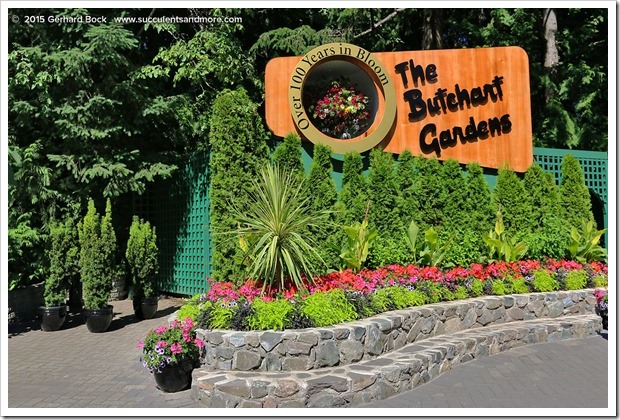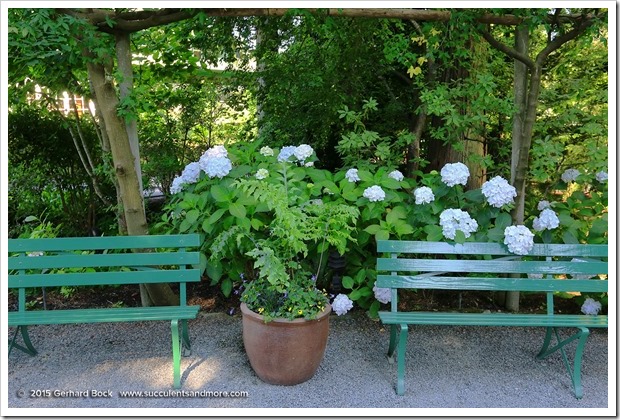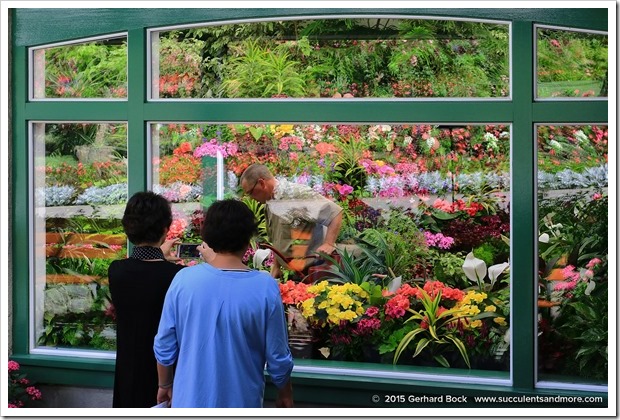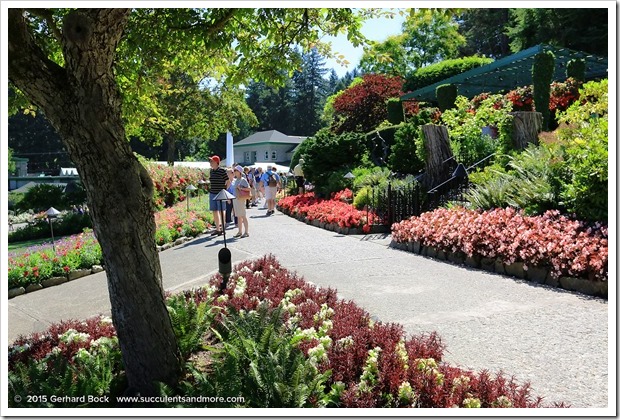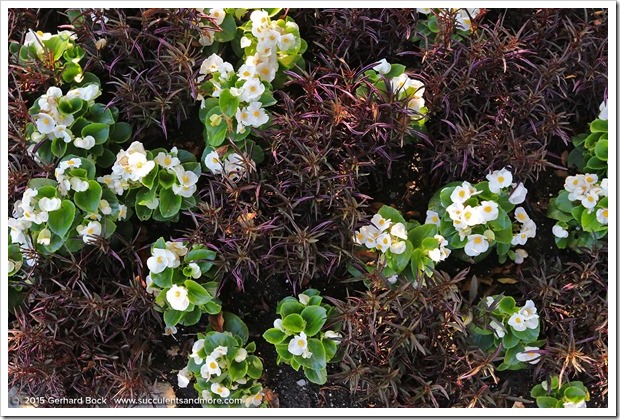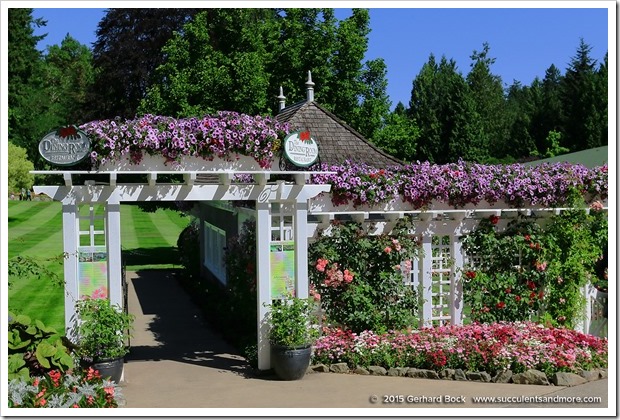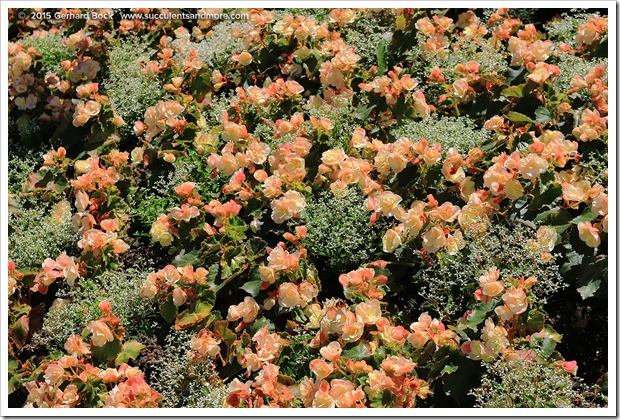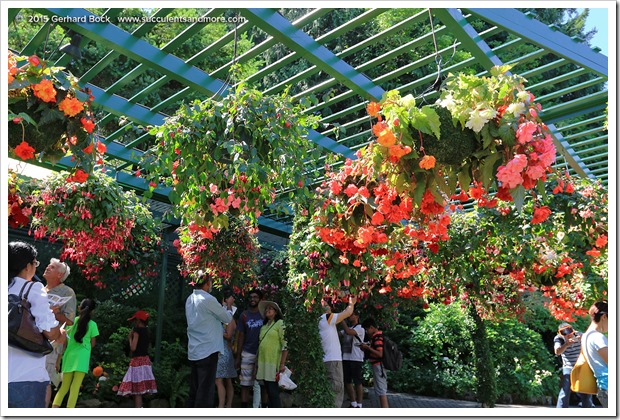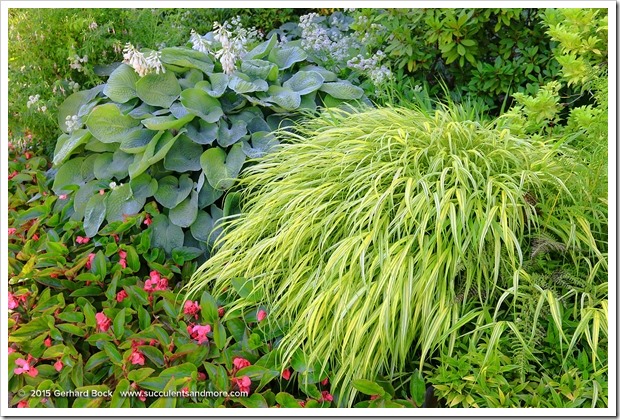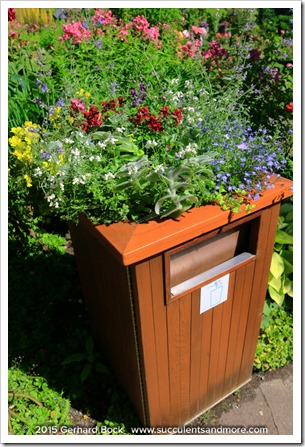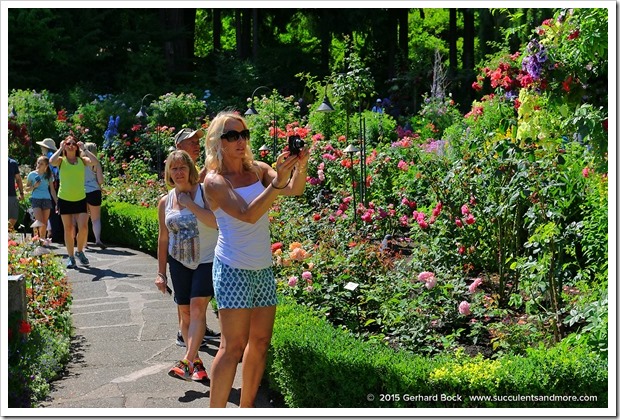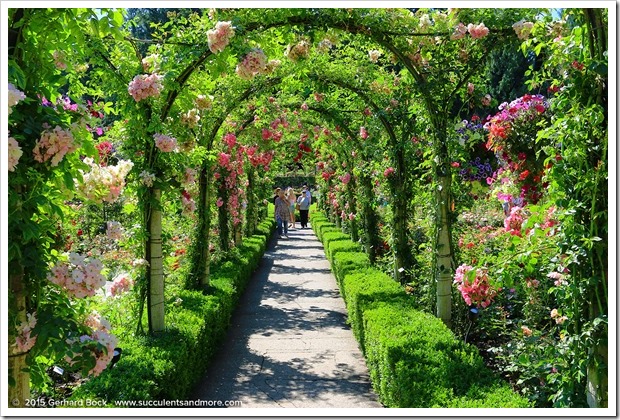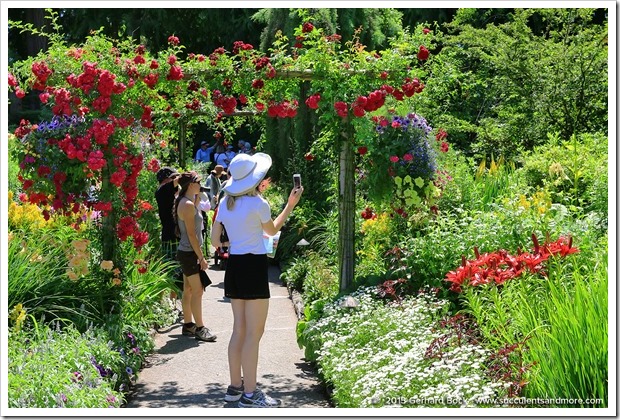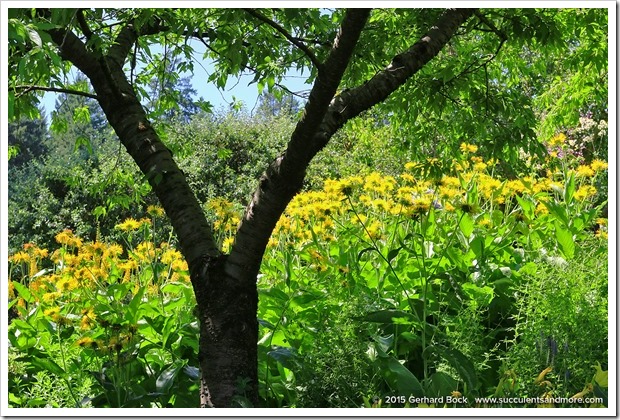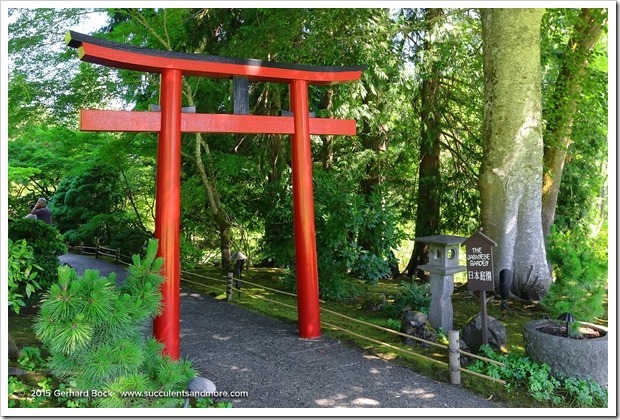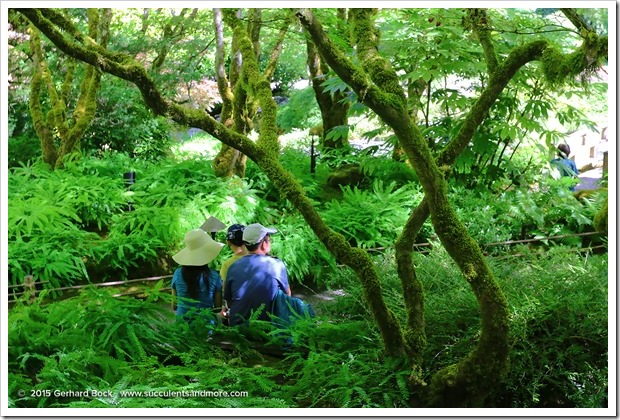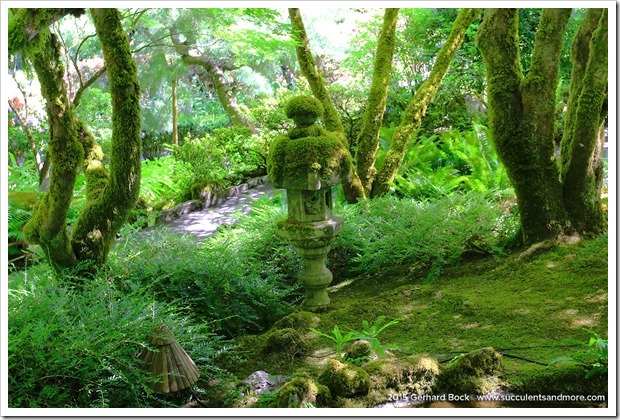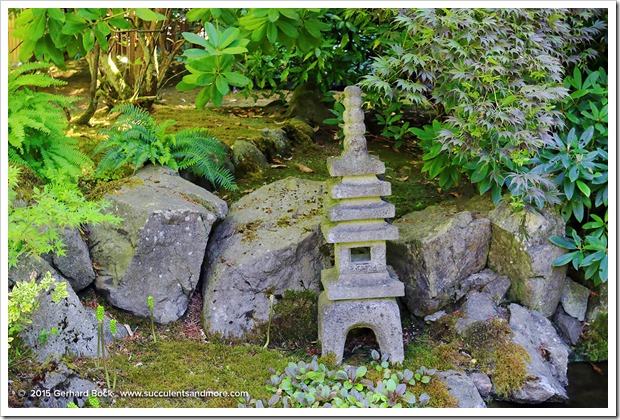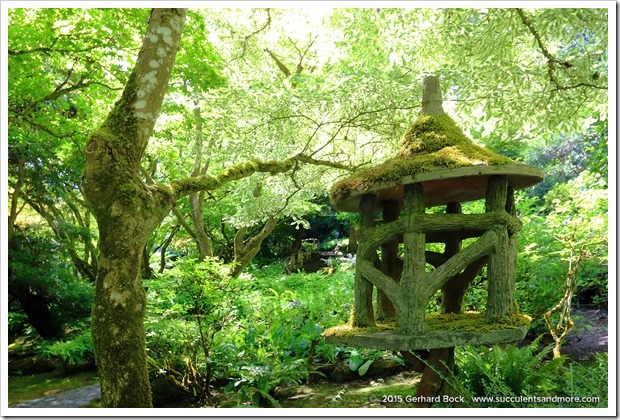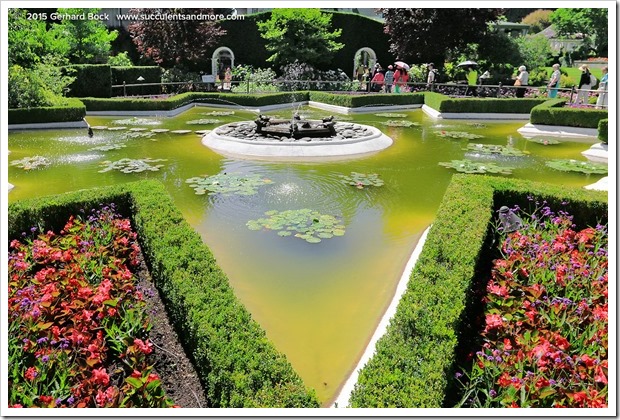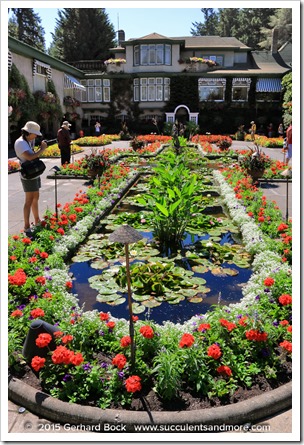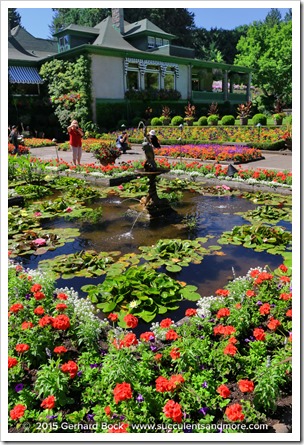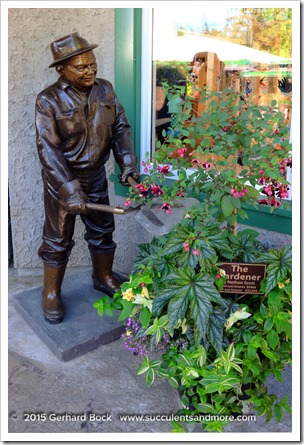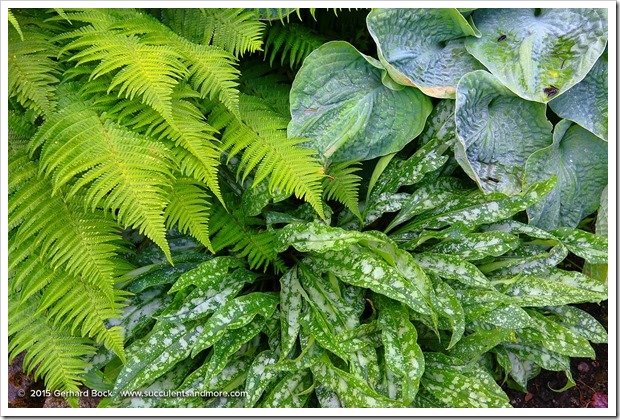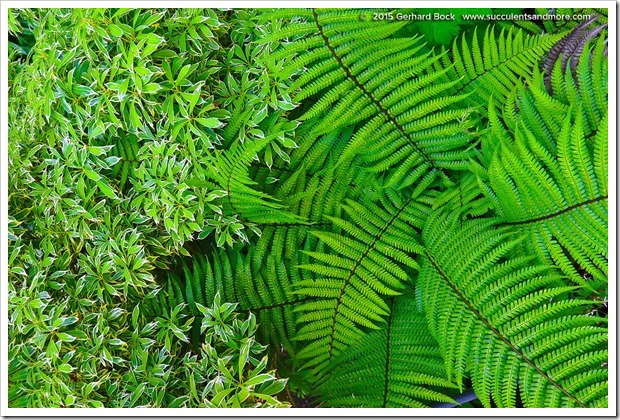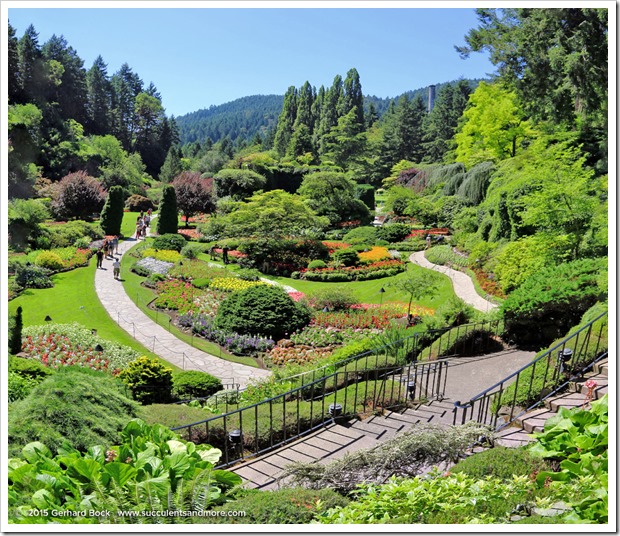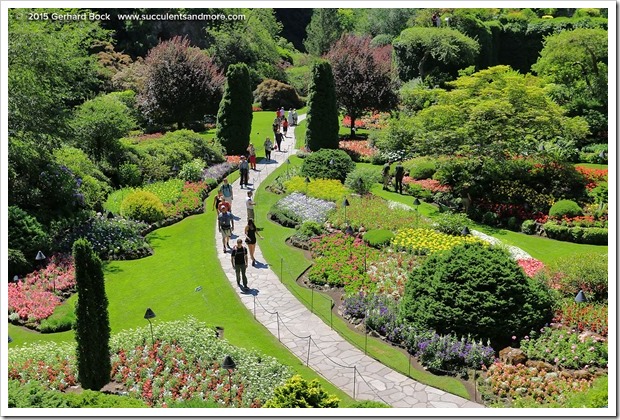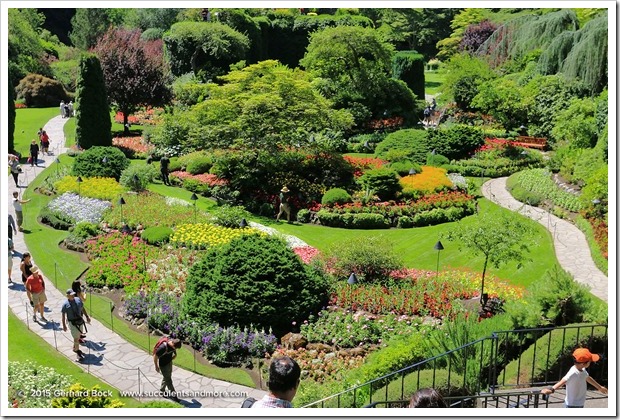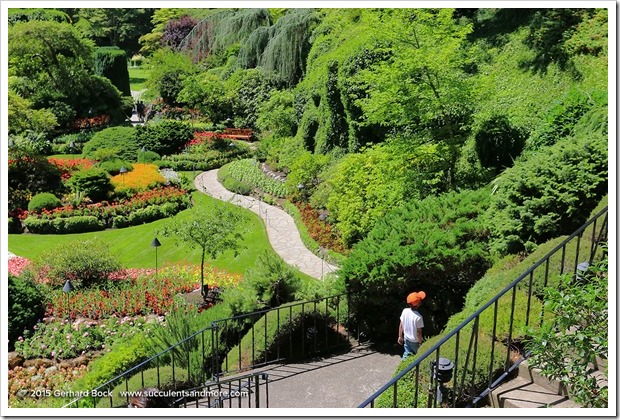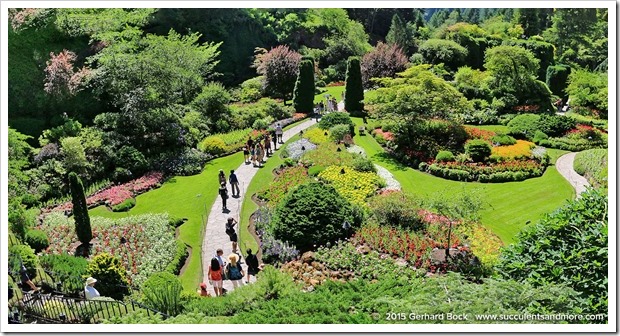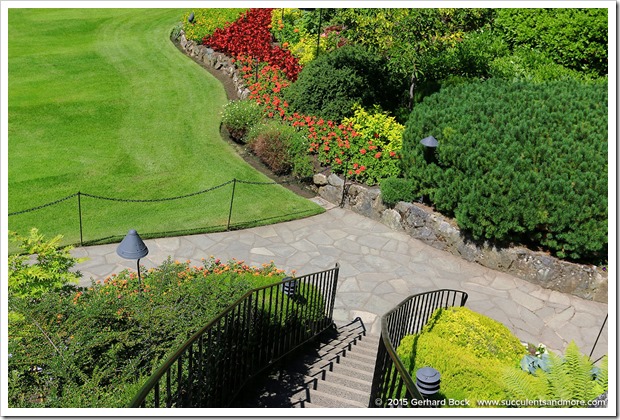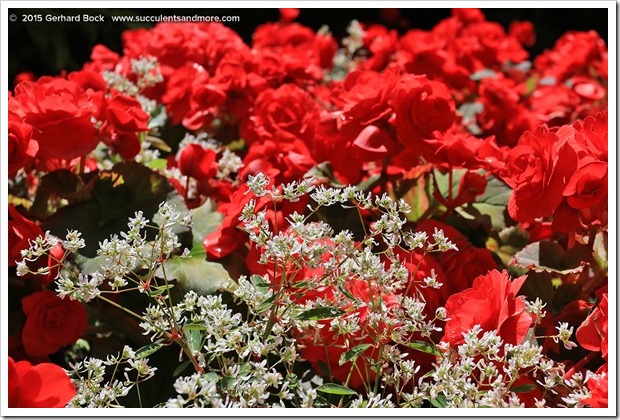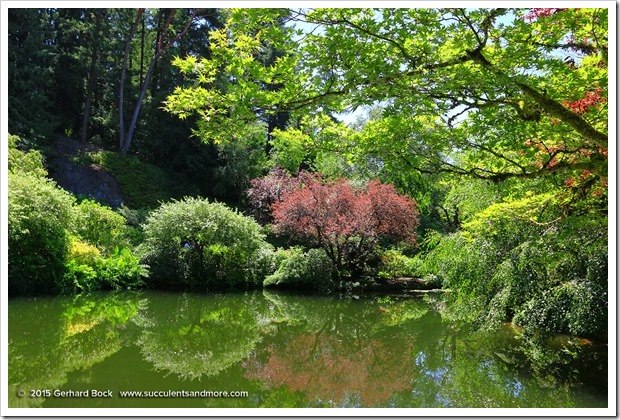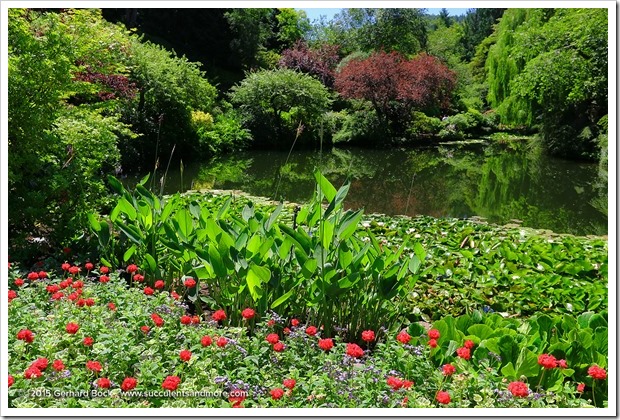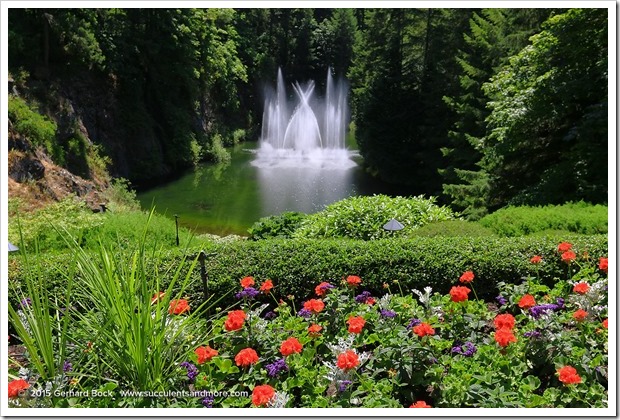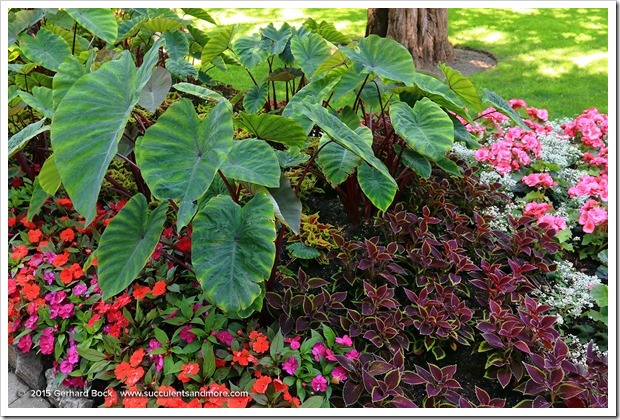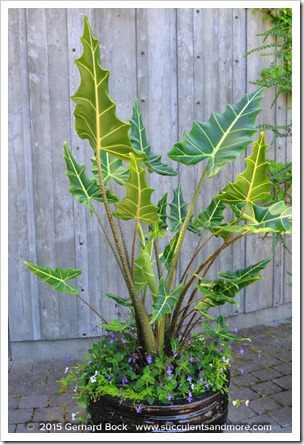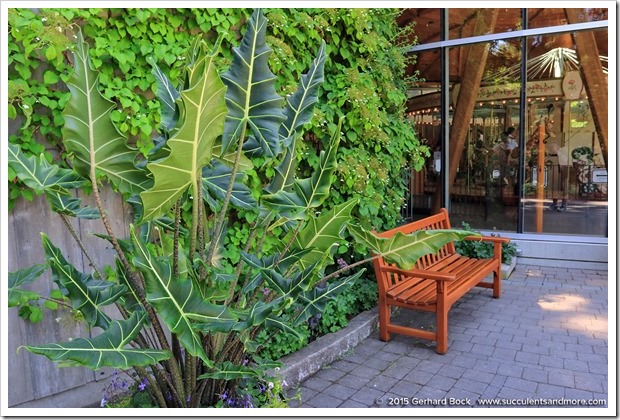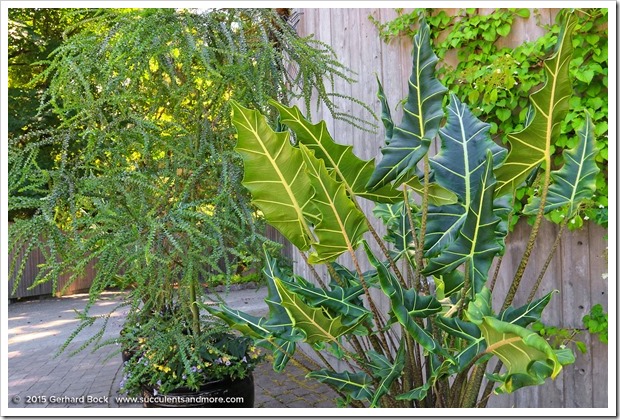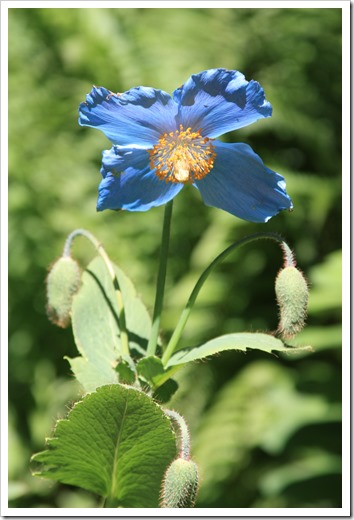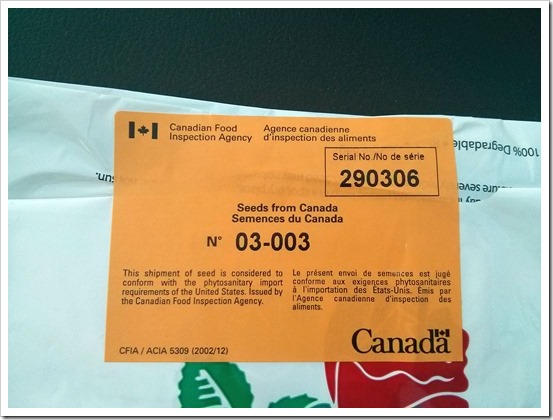With almost a million visitors a year, Butchart Gardens is the most popular botanical garden in all of North America. Talk to friends and relatives, and you’ll be surprised by how many of them have been there, even if it was a long time ago. Some of the infrastructure may have been upgraded (like the gift store and the coffee shop) and a few attractions may have been added (like the Rose Carousel) but the gardens themselves have most likely changed very little. With good reason. Why mess with success?
When Butchart Gardens was started in 1904, it merely reflected the tastes of the time, ranging from the timidly playful to the rigidly formal. Today it seems like a living time capsule from a bygone era overlaid by a more-is-more aesthetic that seems to know no bounds.
Like Willy Wonka’s Chocolate Factory, Butchart Gardens churns out one treat after another after another. Once you’ve started, you can’t stop. You go from one horticultural confection to the next, and even when you’ve reached the saturation point and your stomach starts to roil, your feet carry you forward as if they’re detached from your brain.
And if you feel strangely unsatisfied in the end, you don’t dare say a word because it would seem rude not to love Butchart Gardens. Not when all you hear around you are swooning voices exclaiming how pretty everything is, how precious, how darling.
Look beyond the frilly flowers in preternaturally vibrant colors, though, and you’ll find a backbone of trees, shrubs and perennials that is surprisingly exciting all on its own. I saw foliage and texture combinations that were downright spectactular. The hardscape—paths, walls, rocks, etc.—is masterfully crafted and precisely implemented. And underlying it all is a corporate commitment to sustainability and environmental stewardship. I wonder how many of the 1,000,000 visitors that come here every year see and know that?
What is now Butchart Gardens began to take shape in 1904 when Jennie Butchart, the wife of wealthy cement factory owner Robert Butchart, established several formal gardens around her residence, now the Dining Room Restaurant and administrative offices. One of these gardens was the Japanese Garden, started in 1907.
When the limestone deposits in the nearby quarry were exhausted—limestone being a fundamental ingredient in the Portland cement the Butchart factory was making—Jennie Butchart had the brilliant idea of converting the pit into a sunken garden. Begun in 1909 and completed in 1921, the Sunken Garden is still the centerpiece of the estate.
Reputation of the Butchart’s spectacular gardens spread early, and in 1915—six years before the Sunken Garden was even completed—they already had 18,000 visitors.
Other gardens were added later on, including the Italian Garden (1926) and the Rose Garden (1929).
In 1939, Jennie and Robert Butchart transferred ownership of the gardens to their then 21-year-old grandson Ross who was involved in the operation until his death in 1997. Today, Butchart Gardens is still family-owned and run by great-granddaughter Robin-Lee Clarke.
In 2004, Butchart Gardens was designated a National Historic Site of Canada.
Pond adjacent to the parking lot
Now that you know the basic story, let’s take a walk through Butchart Gardens.
Large bowl of succulents near the garden entrance—with one exception the only succulents I saw at Butchart Gardens
Hydrangeas exhibiting this level of perfection may be common in the Pacific Northwest, but to me they’re as exotic as orchids
This viewing window next to the Blue Poppy Restaurant attracted a great deal of attention from visitors
Floral display inside the viewing window
I’m sure this gardener was aiming for the plants but in this photo it looks like he’s watering the pavement
And the assault on the senses begins…
Wax begonias ( Begonia × semperflorens-cultorum) and some sort of Alternanthera
View of the former Butchart residence, now the Dining Room Restaurant
Entrance to the Dining Room Restaurant
I quite liked this muted color combination
Similar combination with reddish-pink begonias
This patio featuring hanging baskets was particularly popular. I’m sorry to say that all I could muster was a lackluster shrug. To each his own.
These combinations…
…and this one are more to my liking
This combination fires on all cylinders. The glaucous hosta on the left is the perfect foil for the sizzling Impatiens omeiana on the right.
Approach to the Rose Garden (left) and one of many garbage cans (right), appropriately bedecked with flowering annuals
Throngs of people in the Rose Garden
Even my cynical heart softened when I saw these arches
Yes, they are beautiful
Every square inch is filled with plants
Stately Inula hookeri
Red lacquered torii gate marking the entrance to the Japanese Garden
I escaped to the Japanese Garden to take a breather, but as you can see…
…it wasn’t exactly a haven of solitude
This family found a quiet spot
Stone lanterns…
…are my favorite elements in a Japanese Garden
This lantern was the quirkiest design I’ve ever seen. It looked more like a prop from a Hänsel and Gretel movie.
The other entrance to the Japanese Garden, near the wharf on Tod Inlet
Italian Garden
Italian Garden
This color combination made me crave sherbet
Pond in the Italian Garden
Flowering water lily
I saw several of these water bowls for dogs. They reminded me of Japanese water basins.
Formal flower border and perfectly manicured lawn
Two arrangements I really liked. The gardener statue, not so much. If it’s up your alley, it can be yours for $5,800.
Alocasia ‘Stingray’. I appreciated the touch of the exotic amidst all the flowering annuals.
I was surprised to see tapeworm plant ( Homalocladium platycladum) in quite a few combinations. I think it’s a criminally underused gem.
The gift store sells seeds packaged right at the garden. You can find the same selection in their online store.
Another foliage combination I thought was spectacular
Deceptively simple combination, but oh so beautiful
Now we’re at the Sunken Garden, the heart of Butchart Gardens and once an abandoned limestone quarry. The transformation began in 1909 and was completed in 1921. Mountains of rock debris were cleared from the site and later reused to create the central mound in the Sunken Garden as well as for the base and edging of flower beds. Countless tons of topsoil were brought in from neighboring farms on horse-drawn carts. A lake was created in a particularly deep portion of the quarry. Jennie Butchart had herself lowered over the side of the quarry walls so she could tuck ivy into crevices in order to hide the grim look of the gray rock. And finally plants of every description—trees, shrubs, perennials, biennials and annuals—were added in great profusion. Historical photographs show that the Sunken Garden has changed very little since the early days.
Entrance to the Sunken Garden overlook
The Sunken Garden in all its glory
At the far end of the Sunken Garden is the Ross Fountain. It was installed in 1964 under the direction of the Butcharts’ grandson Ian Ross. At night it is illuminated in a rainbow of colors.
I like this neutral green foreground…
…but I bet most photos are taken from this spot, with flowering geraniums in the frame
Now we’re leaving the Sunken Garden behind and continuing on towards the Rose Carousel and Children’s Pavilion (see map here).
I have no idea what tree this is, but it was beautiful backlit by the sun
The inclusion of elephant ears ( Colocasia esculenta) was a nice touch
The surprising element here is Farfugium japonicum ‘Aureomaculatum’
Plantings near the Rose Carousel and Children’s Pavilion
Color-coordinated fire hydrant
LEFT: Acacia pravissima RIGHT: Alocasia × amazonica
Alocasia × amazonica next to the Rose Carousel
View from the other side. As you can see, this combination really captured my attention.
Day lilies and spiny bear’s breeches ( Acanthus spinosus)
Concert Lawn
When we left Butchart Gardens I felt exhausted—much like I feel after spending too much time in a museum or watching too much reality TV. The relentless parade of flowers in every color of the rainbow simply was too much for me.
But in the end it doesn’t matter what I think. Everybody walks away with their own impressions based on their personal likes and dislikes. And even if you don’t love the riot of flowers, you cannot help but admire the epic effort behind it all. I’m talking not just about the creation of the original gardens, but also about the monumental effort required to maintain them, to keep them looking perfect year in and year out. With 50 full-time gardeners and 26 production greenhouses containing 1,000,000 plants, Butchart Gardens is definitely a well-oiled machinery.
It’s easy to see why Butchart Gardens is sometimes compared to Disneyland. Both are precisely controlled environments where nothing is out of place and nothing is left to chance. Personally, I like my garden to have an element of surprise. I don’t want to be in control of everything, I want my plants to do their own thing. But I don’t think this approach works very well when you have 55 acres to keep up.
I did wonder, though, if the gardeners ever feel mischievous and toy with the idea of putting their own twist on what they’re doing, for example sneaking in plants that may not be on the approved list (if there is such a thing) or substituting yet another wax begonia with something a little more odd and daring.
The biggest mystery about Butchart Gardens—and Victoria in general—was the dearth of succulents. The only succulents I saw at Butchart Gardens were that large shallow bowl I showed you earlier in this post as well as a stand of Yucca rostrata I spotted as we were exiting the parking lot (unfortunately I was not able to stop and photograph them). The climate in Victoria (zone 9a) is certainly mild enough for succulents, and its annual precipitation of 36.5 inches (926 mm) is even a tad less than in Portland, OR where many succulents thrive. In Victoria’s gentle coastal climate, succulents that don’t like high heat, such as aeoniums and echeverias, should do well and would fit in with the formal plantings of Butchart Gardens. I imagine even the rather finicky spiral aloe ( Aloe polyphylla) would like it here. So where are they?
_______________________________________
The only souvenir I bought at Butchart Gardens was a package of Himalayan blue poppy ( Meconopsis baileyi) seeds. Our visit was too late in the year to see this rare perennial in bloom, but after having seen an entire area dedicated to it at VanDusen Botanical Garden in Vancouver, BC, I couldn’t resist. Since it prefers cool, moist summers, I’m not sure it will ever amount to much in Davis, but I will give it a try.
“Rhododendronpark Bremen 20090513 263” by Syker Fotograf - Own work. Licensed under GPL via Wikimedia Commons.
The employee at the Butchart Gardens Gift Store carefully placed my seed package inside a plastic bag, sealed it with a special customs sticker, and reminded me to present the bag to the U.S. customs officials when crossing back into the U.S. It continues to amaze me how much bureaucracy is involved in bringing in something as basic as seeds. Let’s not even talk about importing live plants; those hurdles are virtually impossible to overcome for folks like me who aren’t in the trade and don’t have the required permits.
RELATED POSTS:
2015 Pacific Northwest trip index
